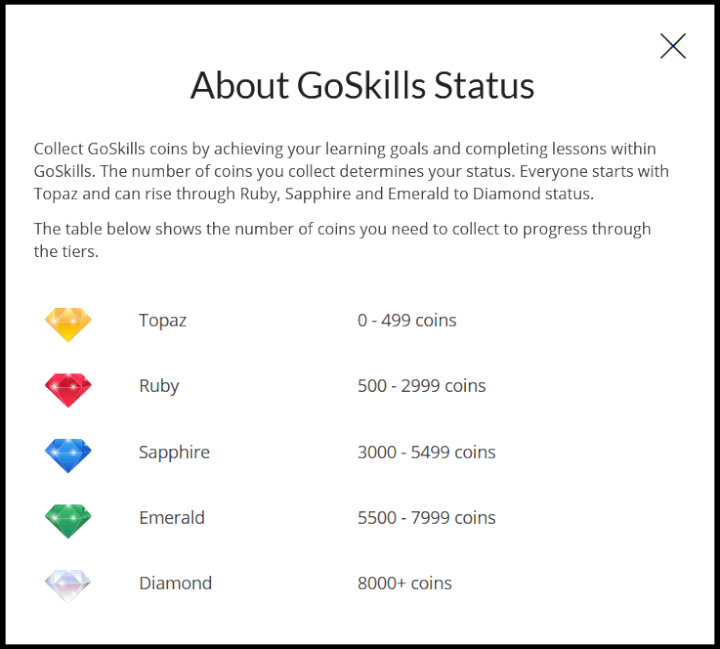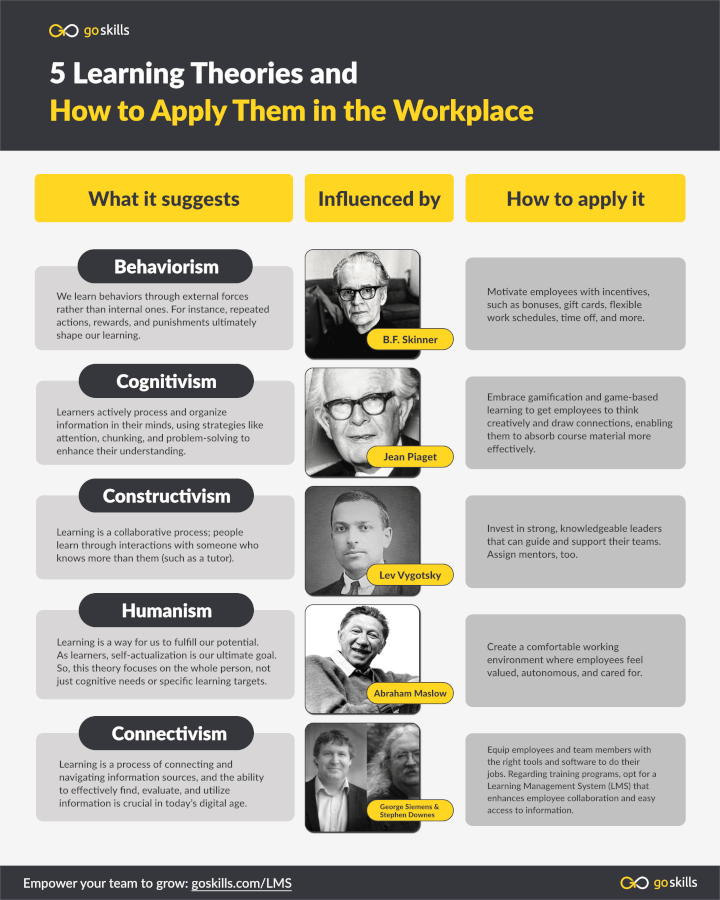You likely already know that people learn differently.
Maybe you learn best when you get to brainstorm and bounce ideas around with a group of people, while your colleague prefers to attend a seminar and not be an active participant. Or perhaps you like plenty of demonstrations and examples, while your deskmate prefers written instruction.
Learning isn’t a one-size-fits-all sort of thing, and that’s exactly where learning theories come into play. These theories explain how we process information, and understanding them will help you deliver information to people in a highly-targeted and effective way.

What are learning theories?
Let’s start with a quick learning theories definition. Learning theories are different sets of principles that explain how individual brains process learning.
Why are learning theories important? Well, because as our introduction highlighted, learning is somewhat individualized. The way that you receive, process, and retain information might not be the same way your team member does.
That’s why learning theories in education are so important. You’ll frequently hear these different theories of learning mentioned in the context of a teacher working with a classroom of students — as opposed to professional or workplace training.
However, learning theories apply outside of formal education, and understanding them enables you to deliver information to your direct reports or team members in a way that makes the most sense for them.
5 learning theories you should know about
There’s no such thing as a good learning style and a bad learning style or a good educational model and a bad educational model. They’re just different.
So, that brings us to your next question. What different theories of learning are out there? Well, there are a lot. But you’ll see these five crop up most frequently:
Are you wincing at those academic-sounding terms? We get it. Fortunately, we’re going to break each one of these learning theories down in detail. Let’s get to it.
1. Behaviorism
Also called: Behaviorist learning theory
The behaviorism learning theory was largely influenced by psychologist B.F. Skinner. This theory suggests that we learn behaviors through external forces rather than internal forces. Things like repeated actions, rewards, and punishments are ultimately what shape our learning.
Think about it in a classroom setting. A teacher might use positive reinforcement by awarding gold stars to students who resist interrupting. The students will learn not to interrupt as they continue to be rewarded with that positive feedback.
One of the most well-known examples of behaviorism in psychology is Pavlov’s Dog. Psychologist, Ivan Pavlov, assumed that dogs would salivate when food was placed in front of them. But, he discovered that the dogs actually began to salivate when they heard the footsteps of the person who was bringing them food.

That connects to another main concept of this learning theory: rote learning. This theory asserts that people learn best through pure repetition and memorization.
How to apply this learning theory in the workplace
One of the most straightforward ways to apply this learning theory in your workplace is to motivate your employees with incentives — such as bonuses, gift cards, flexible work schedules, time off, and more.

How to apply this learning theory in elearning
Feedback is another crucial element of the behaviorist learning theory, as it reinforces desirable behaviors and works to eliminate negative behaviors. By breaking your online learning courses into smaller lessons, you provide more regular opportunities to test knowledge, offer feedback, and monitor progress toward learning goals.
Want to boost your team's success?
Learn why training and development matters (and how to do it right)!
2. Cognitivism
Also called: Cognitive learning theory
The cognitive learning theory focuses on thought or cognition. It’s based on the ideas of psychologist Jean Piaget — particularly what he called schemas, which are ways we organize information and knowledge. Piaget referred to schemas as the building blocks of intelligent behavior.
It’s a bit of a dense theory to understand, but here’s the gist — we aren’t passive when we’re learning. Instead, our brain is actively working to take in information and process it. When we reorganize that information, find new explanations, or tailor old explanations, that’s stored in our memory and influences future learning (and ultimately, behavioral change).
Problem-solving is a great example of cognitivism in action. For example, maybe you see a big dip in your website traffic. You ponder that issue, recall that it happened at this same time next year, and then figure out that it’s due to the seasonality of your business. That’s a simple look at how cognitivism works.
You’ll often hear Bloom’s Taxonomy mentioned with the cognitive learning theory. It’s a framework that classifies different levels of cognition. Basically, cognition is split into sub-categories that are ranked according to their cognitive difficulty. Today, as the Vanderbilt University Center for Teaching explains, those categories include:
- Create: Produce something new
- Evaluate: Justify that new work
- Analyze: Draw connections
- Apply: Use that information in new situations
- Understand: Explain your idea
- Remember: Recall facts
How to apply this learning theory in the workplace
To allow for cognitivism at work, you need to ensure a high degree of psychological safety on your team. This gives people room to suggest new ideas and form conclusions without fear of failure or reprimands.
How to apply this learning theory in elearning
Gamification and game-based learning is a great way to get people to think creatively and draw connections, as it enables them to absorb course material in a different way. Look for a learning management system (LMS) like GoSkills that allows for games within your course modules.

3. Constructivism
Also called: Constructivist learning theory
Think about the root word of this learning theory: construct. That’s a great starting point for this educational theory, which asserts that knowledge is constructed. It builds on itself, as you use previous experiences and information to shape how you perceive and use new knowledge. That means learning is highly individualized.
However, constructivism is built on the ideas of psychologist Lev Vygotsky, who also believed that learning is a collaborative process and that people (specifically, children) learn through interactions with someone who knows more than them (such as a tutor).

How to apply this learning theory in the workplace
To use this theory, you’ll need strong, knowledgeable leaders that can guide and support their teams. Mentorship can also be a valuable piece of this learning theory, as it gives employees the opportunity to learn from others who are more established in their careers.
How to apply this learning theory in elearning
Even though many online learning opportunities are self-paced, you should still provide plenty of opportunities for interaction with others through social learning and knowledge sharing. GoSkills offers both of these features for teams.
4. Humanism
Also called: Humanistic learning theory
This learning theory all comes back to Maslow’s Hierarchy of Needs, which shares five tiers of human needs in a specific order:
- Physiological needs: Food, water, warmth, etc.
- Safety needs: A sense of security
- Belongingness and love needs: Relationships and friendships
- Esteem needs: A sense of pride and accomplishment
- Self-actualization: The feeling of achieving our full potential
The needs that are at the base of the hierarchy (such as physiological or safety needs) must be met before we can start to satisfy the needs that are closer to the top of the pyramid.
The humanistic learning theory says that learning is a way for us to fulfill our full potential. As learners, self-actualization is our ultimate goal. So, this theory focuses on the whole person and not just cognitive needs or specific learning targets.
How to apply this learning theory in the workplace
While it sounds simple, you need to ensure that employees’ most basic needs are met before you can expect them to do their jobs well or learn new information. This can include things like:
- Comfortable working environments
- Job security and stability
- Adequate benefit plans
- Support from HR and other leaders
When those are in place, employees are better equipped to learn in pursuit of self-actualization.
How to apply this learning theory in elearning
Again, it’s important to ensure that people’s basic needs are satisfied. Rather than doling out remote elearning opportunities and expecting people to adapt to them, ensure that you’re taking the time to check in with your employees on a more personal level.

5. Connectivism
Also called: Connectivism learning theory
Given our increasing access to technology, learning looks a lot different than it did even a few years ago. That’s where connectivism comes into play. It’s one of the newest learning theories that suggest we start to look at learning differently — particularly with our use of technology.
This theory aims to be more relevant to our modern society than some of the older theories. It was established by researchers and educators George Siemens and Stephen Downes. As Florida International University explains, they identified eight principles of connectivism:
- Learning and knowledge rests in diversity of opinions.
- Learning is a process of connecting.
- Learning may reside in non-human appliances.
- Capacity to know more is more critical than what is currently known.
- Nurturing and maintaining connections is needed for continual learning.
- Ability to see connections between fields, ideas, and concepts is a core skill.
- Accurate, up-to-date knowledge is the aim of all connectivist learning.
- Decision-making is a learning process.
How to apply this learning theory in the workplace
Because connectivism is based on our use of technology, it’s important that you equip employees and team members with the right tools and software to do their jobs.
Additionally, you’ll need to provide adequate training so that they feel empowered to use those technology tools appropriately.
How to apply this learning theory in elearning
Remember that accurate, up-to-date information is a core principle of connectivism. This means you can’t create a library of online learning resources and then let it sit.
Make sure you evaluate your courses and learning materials regularly to ensure you’re always giving employees and learners the most recent and relevant information. Look for an LMS (like GoSkills) that has easy management of your course catalog.

Understanding learning theories will help you deliver information effectively
When you teach something, you don’t want that information to go in one ear and out the other. You want people to absorb it, consider it, and ideally, retain it.
That’s hard to do if you use a blanket approach. When you understand learning theories and how they impact our ability to learn, you can teach people in a way that’s far more impactful.
We’ll admit that learning theories can be a bit dense and academic to grasp, but that’s exactly why we created this guide. Use it to familiarize yourself with each learning theory, as well as how that theory applies in the workplace and in elearning.
After that? You’re well on your way to educating your employees in a way that actually resonates with them.
Looking for an LMS that helps you deliver information effectively? Get started with GoSkills today.
A better way to train
It's easier than ever to create, track, and manage team training with the GoSkills LMS.
Start for free



